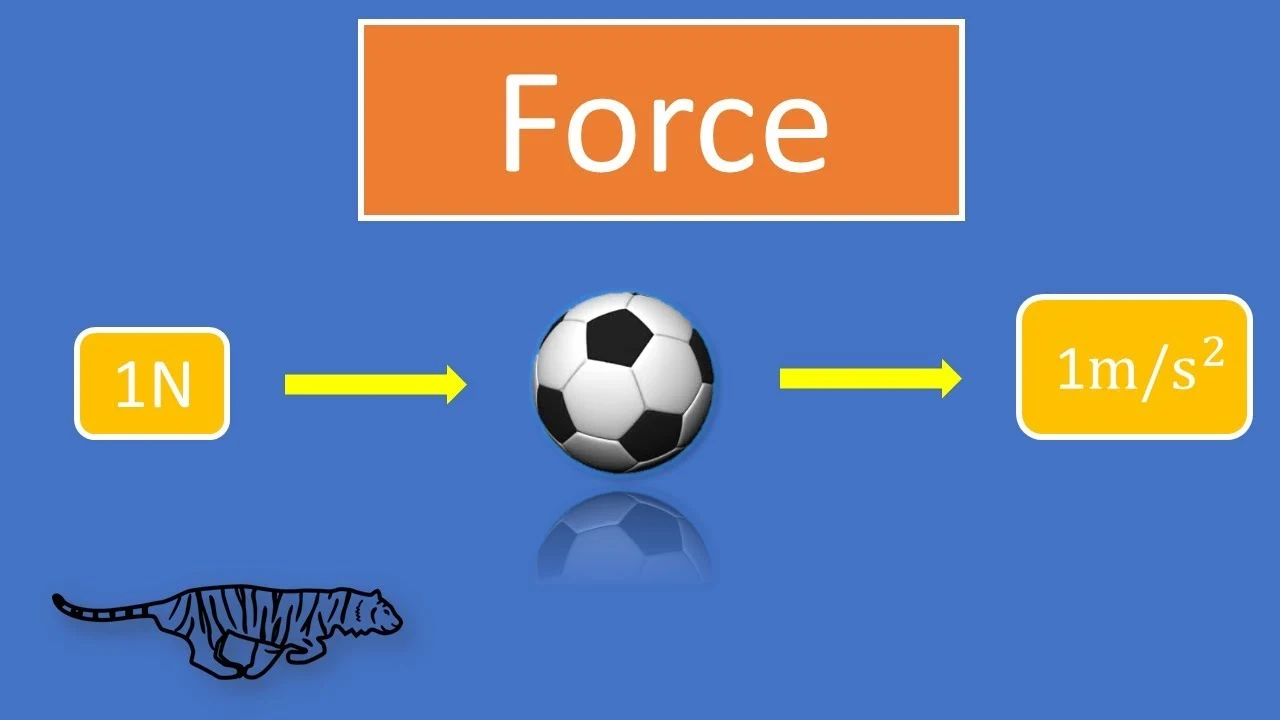
What is a force?
A force makes it possible to make the action of one body on another.
A force is actually defined from its effects: The static effect and the dynamic effect.
An effect is said to be static when it is capable of bringing a body to rest, deforming it or modifying it.
An effect is said to be dynamic when it is able to set a body in motion or to modify the movement of the body.
| Common symbols: | F→, F |
| SI unit of force: | Newton |
| In SI base units: | kg·m/s2 |
| Other units: | dyne, pound-force, kilo pond |
| Derivations from other quantities: | F = m a |
| Dimension: | LMT-2 |
The effects of a force
A force is susceptible:
- to modify the speed of a body (possibly to set it in motion or stop it),
- to modify the trajectory of a body (forces that compensate each other),
- to deform this body.
Depending on the situation, force can produce one of these effects, two of them or all three simultaneously.
The effect obtained depends on the orientation of the force, its direction, its value and the nature of the body that is subjected to this force.
The different types of forces
We distinguish between contact forces and distance forces.
Remote forces
Forces at a distance can be exerted without contact between objects. The main ones are:
- The force of gravity: the force of gravity is a fundamental force which corresponds to the mutual attraction exerted between two bodies of significant mass. Thus the law of gravitational force demonstrates that two bodies of different masses placed at two distinct points, exert directly opposite forces of attraction on each other. It was Isaac Newton who had the idea of universal gravitation by watching an apple fall. The forces of gravity are exerted as well over great distances as for example astronomical distances (celestial bodies …) as much smaller distances that is to say microscopic (between nucleus, atoms etc …)
- Magnetic force: it is the force which allows a magnet to attract a piece of iron or which directs the needle of a compass towards north. Magnetic forces act at a distance. For example, a piece of iron and a magnet exert forces on each other at a distance. Magnetic forces act either by attraction or by repulsion.
- Electrical force: This is the force that attracts pieces of paper towards a plastic rod that has been rubbed or that sets electrons in motion in an electrical circuit. Thus two electrically charged bodies exert forces at a distance on each other: if the bodies have identical charges, then they repel each other. On the contrary, if the bodies have different charges, they attract each other. Electric forces increase as the distance between bodies decreases.
- Nuclear forces: these are forces that hold nucleons together and ensure the stability of the nucleus of atoms. Nuclear forces are sometimes referred to as strong residual forces. In reality it is not one or two nuclear forces but three different forces which are exerted within the atoms. A first strong force of interaction allows the cohesion of the nucleus. The second force is electromagnetic and is rather repulsive but less important than the first. Finally, the third force is weak and acts even within the nucleons.
Reminder: what is a nucleon? Atoms represent the basic building blocks of matter. They are composed of a nucleus, formed of protons (positively charged elementary particles) and neutrons (uncharged elementary particles), around which the electrons revolve. Protons and neutrons are also called nucleons. The number of nucleons per atom is given by the mass number A.
Contact forces
Contact forces are manifested when a body is in contact with another body (solid, liquid and gas) .
The main contact forces are:
- The reaction force of a surface (ground, table or other): when a solid is placed on a support, the latter exerts forces on the solid at each of the points of contact. These are forces that oppose weight and prevent an object from falling. This force is usually vertical and upward and often offsets the weight. If the solid is in equilibrium on the support, the forces compensate for the weight of the solid. The set of contact forces is equivalent to a single force called the reaction of the support. (This distorts the support which pushes back the body).
Example: the contact of an object with another object: when two solid surfaces are in contact with each other, they exert a reaction called normal reaction on each other. The normal reaction forces are perpendicular to the contact surface otherwise the solids would interpenetrate between them. - Pressure forces exerted by a gas or a liquid : fluids exert on bodies in contact with forces which are said to be delocalized.
Example: Archimedes’ principle.
Archimedes was a scholar of antiquity well known for his principle of the Archimedes’ principle”.
Any body immersed in a fluid at rest, entirely wetted by it or crossing its free surface, undergoes a vertical force, directed from bottom to top and opposite by weightthe volume of fluid displaced; this force is called Archimedes’ thrust. “
According to some stories: Archimedes explains that he would have discovered this principle while taking his bath.
The application of Archimedes’ principle makes it possible to understand the forces allowing the buoyancy of boats or the principle of hot air balloons.
- Friction forces exerted by a surface or by air on a moving object: these are forces that oppose the relative movements between two systems in contact. The frictional forces are in fact caused by the presence of microwelds which develop between the surfaces and ultimately this creates a good bond. The friction forces therefore depend on the nature of the surface and on the normal and are independent of the contact area and of the speed.
The characteristics of a force
A force can be defined from different elements which make it possible to characterize a vector:
- Its direction
- Its meaning
- Its value or norm calculated in Newton and which can sometimes be called intensity
- Its point of application
Representation of a force
The characteristics of a force (directions, direction, point of application and value) are also those corresponding to a vector.
A force is therefore represented by a vector having the same direction and the same direction as the latter and having a length which is proportional to its value (by choosing a scale of representation).
Example: a vector representing the weight of a balloon
How to take stock of strengths
Taking stock of or making an inventory of forces consists of making a list of all the forces exerted on an object.
Examples:
- An object placed on a table is subjected to its weight and to the reaction force of the table.
- An object that sinks in water is subjected to its weight, to the principle of Archimedes and to the friction of the water.
- A windsurfing board in motion on water is subjected to its weight, the contact force of the wind, the friction of the water as well as the Archimedean thrust (these last two forces can be included in the reaction. some water).
Forces that compensate for each other
Two forces offset each other if they have:
- The same direction
- Opposite senses
- The same value
If they are represented by vectors, they are opposite.
Example :
When an object is suspended from a wire, the contact force exerted by the wire compensates for the weight of the object
How do you measure a force?
The force is expressed in Newton which is represented by an N.
To determine the value of a force, you can use a dynamometer. It is about a device whose deformation is proportional to the tensile force (called T) which it exerts or the force F which it undergoes.
Thus the dynamometer consists of a spring which lengthens according to the force. Depending on the stiffness of the spring used, the dynamometer can evaluate more or less important forces.
The maximum elongation is always given by the manufacturer. At each measurement, care must be taken to ensure that the device returns to zero so that all subsequent measurements are reproducible.
The table below gives some examples of Newton derivative units sometimes used:
| Derived units | Value |
| Kilo Newton | 1000 Newton |
| Deci Newton | 0.1 Newton |
| Centi Newton | 0.01 Newton |
| Milli Newton | 0.001 Newton |
What we have covered in this article
- What is a force?
- The effects of a force
- The different types of forces
- The characteristics of a force
- Representation of a force
- How to take stock of strengths
- Forces that compensate for each other
- How do you measure a force?
Related Articales
Recently Posted
-
भगवान गौतम बुद्ध जीवन परिचय | Gautam Buddha in Hindi
December 15, 2022. -
कार्बन के अपररूप Allotropes of Carbon in Hindi
November 5, 2022. -
मिश्र धातु किसे कहते हैं? उपयोग, नाम, गुण Alloy in Hindi
July 27, 2022. -
गलनांक किसे कहते हैं? परिभाषा, उदाहरण Melting Point in Hindi
July 20, 2022. -
परिमाप किसे कहते हैं? Perimeter in Hindi
July 19, 2022.




